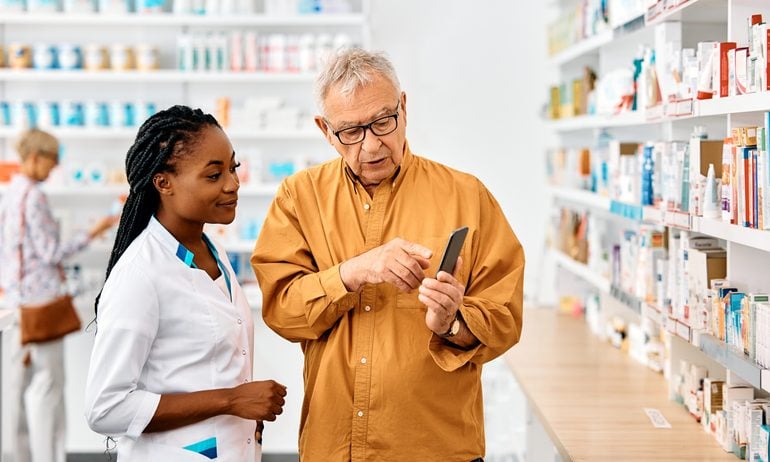How Does GoodRx Work?
GoodRx can offer significant discounts on prescription drugs for customers paying cash, but it may not be the best option for everyone.

Many, or all, of the products featured on this page are from our advertising partners who compensate us when you take certain actions on our website or click to take an action on their website. However, this does not influence our evaluations. Our opinions are our own. Here is a list of our partners and here's how we make money.
Prescription discount cards help people save money on prescription drugs by offering savings at participating pharmacies. One popular company, GoodRx, offers discounts of up to 80% on prescription drugs at over 70,000 U.S. pharmacies with its prescription savings program.
GoodRx can offer significant savings at the pharmacy counter, especially for patients without insurance coverage for prescription drugs, but there are some potential drawbacks, too.
Here’s what you need to know about saving money on prescriptions with GoodRx.
What is GoodRx?
On GoodRx’s website and app, you can enter your location and prescriptions to look up and compare prices at participating pharmacies near you. To get those prices at the pharmacy, you print and bring a free GoodRx coupon or show it on your phone when picking up your prescription.
The coupon tells you the cash price you can pay, which could be cheaper than an insurance copay or the pharmacy’s cash price for the prescription if you’re not using insurance.
(GoodRx also offers prescription drug savings cards that you can bring to pharmacies to get the GoodRx price, but using the website or app lets you find out what you’ll pay before you get there.)
The GoodRx price is an alternative you can pay instead of using insurance, not a discount on your copay. “Keep in mind you cannot use GoodRx and insurance at the same time,” the company’s website says.
Using a GoodRx coupon means you’re doing a “cash” payment for your medications. (In this context, paying “cash” means you’re paying out of pocket — without insurance.)
Who is GoodRx best for?
GoodRx is an option to consider if you’re facing high out-of-pocket costs for your prescription drugs. You’re free to choose whether or not to use GoodRx when filling a prescription, so you might want to use it for certain prescriptions and use insurance or other options for others.
If you don’t have insurance or if your insurance doesn’t cover your prescription drug, GoodRx can probably offer savings on the cash price you might otherwise have to pay entirely out of pocket.
For example, for a 30-count supply of 400 milligrams of Imatinib, a cancer drug, in Minneapolis, GoodRx shows coupon prices as low $88.74, compared to a full retail price of $7,666.
If you do have insurance that will cover your prescription, you might still want to compare prices against GoodRx. If you would have high copays or coinsurance, you might want to consider paying GoodRx’s discounted cash price instead.
For example, for the same Imatinib prescription that costs as low as $88.74 through GoodRx, Medicare Part D prescription drug plans available in Minneapolis have out-of-pocket costs ranging from about $36 to over $2,500.
Medicare Part D plans are some of the easiest to compare because their drug pricing is public on Medicare.gov. Other types of insurance might also have a price lookup tool that you can use to compare prices ahead of time. Depending on your plan, GoodRx could end up being a much cheaper option.


Get the Care You Need
What are the potential drawbacks of GoodRx?
GoodRx can offer significant savings on prescription drugs, especially for people paying without insurance or facing high out-of-pocket costs through their insurance. But it’s not without some potential drawbacks.
Here are a few considerations to be aware of.
Deductibles
“When using GoodRx instead of your insurance, the amount you pay will not be automatically applied toward your deductible,” the company’s website says. However, GoodRx recommends contacting your insurance company to ask if you can submit receipts to get credit toward your deductible.
Whether meeting the deductible matters to you depends on your coverage and what you expect to spend on prescription drugs each year.
“Who cares if it’s not going to count toward your deductible if you were never going to spend so much that you’re going to hit your deductible anyway,” says pharmacist Shannon Rotolo, who recently left the University of Chicago for a new position at the University of Rochester.
But if you know that you’ll spend enough to hit an out-of-pocket maximum or Medicare Part D catastrophic coverage, Rotolo recommends having it count toward your deductible. “Get the lower prices from your insurance plan sooner in the year,” she says.
Privacy
GoodRx’s “not-so-good privacy practices” made it the first-ever company penalized for violating the FTC’s Health Breach Notification Rule, according to a post by senior attorney Lesley Fair on the agency’s business blog.
“In our complaint, we alleged that GoodRx violated the FTC Act (which prohibits unfair and deceptive practices in the marketplace) by sharing sensitive personal health information for years with advertising companies and platforms — contrary to its privacy promises that it would not do so,” FTC spokesperson Juliana Gruenwald Henderson wrote in an email.
The FTC imposed a $1.5 million civil penalty on GoodRx. (For context, that’s about 0.2% of the company’s 2022 annual revenue of $766.6 million.)
The FTC also prohibited GoodRx from sharing any of its users’ health data with third parties for advertising, and the company must obtain consent before sharing data for any non-advertising purpose.
When asked whether and to whom GoodRx sells or shares patient data today, a company representative referred in an email to a February 2023 “GoodRx Response to FTC Settlement.”
“The settlement with the FTC focuses on an old issue that was proactively addressed almost three years ago, before the FTC inquiry began,” the GoodRx statement says. The company disagrees with the FTC’s allegations and does not admit wrongdoing.
GoodRx says in its statement that “privacy and security are paramount to us and an essential part of how we conduct our business,” and it encourages customers with questions to review the company’s privacy policies.
Predictability
GoodRx’s prices “fluctuate frequently — daily, weekly or monthly” the company’s website says. So it might be hard to predict what you’ll pay and where you’ll have to go for your medications from month to month.
Prices for common generic medications on GoodRx can change by hundreds of dollars per fill over just six months, according to research published in 2022 by Rotolo and colleagues in the journal Supportive Care in Cancer.
“Even in an urban area with a high density of pharmacies, a patient seeking the least expensive source of five common supportive care medications may have to visit five different pharmacies to get the lowest price on all medications,” that journal article says. During the study, one example required more than an hour of driving to get the lowest prices, not including traffic, parking or pharmacy wait times.
For the sake of consistency over time, you might want to stick with one local pharmacy and pay its cash price, even if it’s a little more expensive than the current cheapest offer on GoodRx, Rotolo says (although the price difference will sometimes be much higher, she acknowledges).
If you’d prefer to get everything in one place rather than get the lowest price for each individual prescription, GoodRx has a feature in its app that “analyzes your entire list of prescriptions and helps you identify the pharmacy offering the lowest overall price,” according to its website.
Pharmacy choice
To get the lowest price with GoodRx, you may have to use a specific pharmacy — probably a large chain.
“A lot of [independent] pharmacies won’t even accept the GoodRx card,” says pharmacist Jessica Robinson, assistant professor at East Tennessee State University’s Gatton College of Pharmacy.
Smaller pharmacies might not be able to afford it.
“What happened was independent pharmacies were very excited to help patients any way they can, and then found out that a lot of the price negotiations are reimbursing below the cost of the drug,” Robinson says.
Pharmacies don’t get to negotiate with GoodRx, Robinson says, but “they are usually willing to sell a medication to a cash-paying patient at cost.” So while an independent pharmacy might not take GoodRx, they may have other options to help you afford medications.
Additional help
There are several options for help affording medications that you might want to consider along with GoodRx:
Pharmacies: “I always recommend going to your traditional mom-and-pop independent pharmacy and asking them if they can help you with a cash plan or cash price,” Robinson says.
Manufacturers: “A lot of manufacturers will have really comprehensive patient assistance programs” that can help with the cost of their brand-name drugs, Robinson says.
Cost Plus Drugs: Cost Plus Drugs is an online pharmacy offering low-cost generic medications delivered by mail. But as with GoodRx, you generally can’t use insurance.
Nonprofits: Grants to help patients afford out-of-pocket costs for medications are available from nonprofits such as the Patient Access Network Foundation, the HealthWell Foundation and the Patient Advocate Foundation.
A version of this article, written by NerdWallet, was originally published by The Associated Press.





